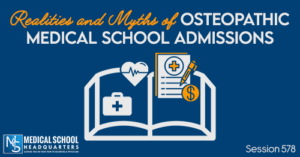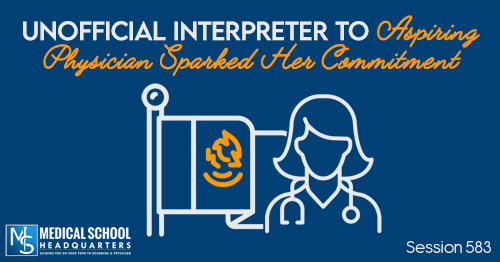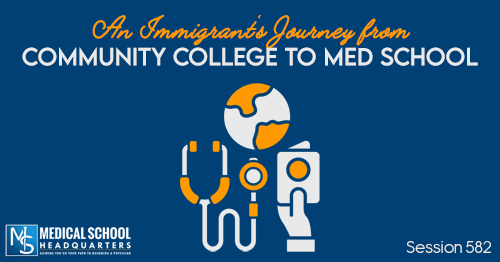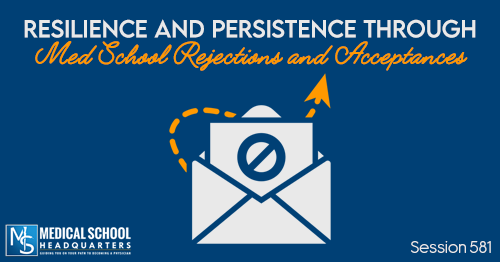Session 578
Austin is the Director of Admissions at Burrell College of Osteopathic Medicine who provides valuable insights into the medical school application process. In this podcast, he emphasizes the importance of authenticity and holistic review in admissions, while also discussing Burrell’s commitment to diversity and their new Florida campus.
For more podcast resources to help you with your medical school journey and beyond, check out Meded Media.
Listen to this podcast episode with the player above, or keep reading for the highlights and takeaway points.
How Austin Got into the Medical School Admissions World
Austin explains that he discovered a passion for working with students while working in undergraduate admissions and financial aid. He saw an opportunity to give back to healthcare in a unique way by helping others reach their dreams of becoming doctors.
“Being in admissions is great because I get to see other dreams come true through individuals in our two campuses.”
Comprehensive Post-Cycle Advising for All Non-Matriculating Applicants
Austin acknowledges the difficulty of rejecting many applicants and crushing their dreams. He explains that Burrell tries to balance this by offering post-cycle admission advising appointments to all applicants who weren’t accepted. They provide personalized feedback and guidance on how they can improve their application for future cycles. This approach helps Austin feel better about the process, knowing they’re giving rejected applicants tools to potentially succeed in the future.
Austin clarifies that they actually do offer post-cycle advising appointments to all applicants who submitted an application but did not matriculate, not just a select group. He explains that while thousands of applicants are eligible, not everyone takes advantage of the opportunity. But they encourage all non-matriculating applicants to schedule an appointment for personalized feedback.
Why Students Aren’t Getting In
According to Austin, besides academic qualifications, one of the main reasons students don’t get in is related to tone in their essays and interviews. He mentions that sometimes students don’t share enough information or expand too much on questions during interviews, which can be red flags for admissions committees.
Austin explains that while arrogance isn’t the most common issue overall, it does occur when students elevate their experiences to an unrealistic level or fail to recognize their true areas for improvement.
“There’s a fine line between sharing who you are and what you’re proud of.”
Austin highlights that even students with perfect academic credentials might struggle in other important areas. He expresses pride in Burrell’s admissions process for considering a balance of strengths and weaknesses across applicants. The school recognizes that healthcare needs diverse skills and qualities beyond just academic excellence.
The Value of Clinical Experience in Medical School Admissions
Austin explains that while they don’t explicitly require clinical experience, they strongly encourage it. He emphasizes that clinical experience allows students to sample the medical field before committing to it.
This is important given the significant time, effort, and financial investment required for medical school. The goal is to ensure students truly want to be physicians and have a realistic understanding of what that entails.
“It would be disingenuous for colleges to want to bring in students who don’t have any medical experience because it feels almost like a bait and switch.”
Austin emphasizes that medical school is a significant commitment in terms of time, effort, and finances. He believes it would be disingenuous for colleges to admit students without any medical experience, as it could lead to a “bait and switch” situation where students might not fully understand what they’re getting into.
Gaining Experience: Quality Over Quantity
Austin advises students to focus on gaining and growing their own experiences rather than trying to meet an unknown metric set by schools. He encourages students to do what they can in terms of clinical experience, allowing the admissions committee to evaluate that experience based on their internal criteria.
“It’s important for students to not worry so much about what the school is wanting and to focus on what they’re able to do and how they can grow their experience… Do what you can, and let us kind of dictate what that looks like behind the scenes.”
The Rationale Behind Limited Transparency in Medical School Admissions Criteria
Austin explains that being vague about experience requirements allows students to shine in their own way, rather than just focusing on meeting specific metrics. He notes that if they were completely transparent, high-achieving students might simply aim to meet the exact requirements, potentially missing the opportunity to showcase their unique qualities and passions.
Additionally, Austin explains that setting specific minimums for volunteer work and shadowing could inadvertently exclude potentially excellent physicians who may not have had equal access to these opportunities.
By keeping requirements open-ended, Burrell can maintain a truly holistic admissions process that considers applicants from diverse backgrounds and circumstances.
Be You, Not Who You Think We Want: The Secret to Med School Apps
Austin emphasizes that they want to hear who the applicant truly is, whether they’re a traditional or non-traditional student, and what unique advantages their background brings. He advises against trying to shock or impress with rehearsed answers or trauma dumping. Instead, applicants need to articulate their thoughts authentically.
“Stop trying to fit with the med school wants you to be – just be yourself.”
Austin stresses that admissions officers are skilled at filtering through exaggerated information and prefer to hear genuine, human responses from applicants.
Authenticity Over Checklists: What Med Schools Really Want to See
Austin explains that when students ask what the school is looking for, he emphasizes the importance of authenticity. He encourages students to share who they truly are.
Whether traditional or non-traditional, focus on your unique advantages rather than trying to fit a perceived mold. Austin stresses that they want to hear genuine thoughts and passions, not rehearsed or exaggerated responses.
“Sometimes in the application process for medical school, students forget that we’re humans – and we want to hear from a human as well.”
Personalized Roadmaps for Med School Reapplicants
Austin explains that Burrell’s admissions is a very individual process, and they use a holistic review approach. He explains that they provide personalized feedback through post-cycle advising appointments. They can discuss specific areas for improvement, whether it’s interview skills, test scores, or other aspects of the application. This approach helps students understand their unique situation and how to strengthen their application for future cycles.
“All because a student has one point off of a recommendation doesn’t necessarily mean they’re not going to be a great physician.”
Burrell Seeks Diverse Talent – Not Just Top Test Scores
While academic metrics are important for initial screening, Burrell’s admissions process aims to be inclusive and diverse, according to Austin. He explains that they look beyond just numbers to consider a wide range of qualities and experiences. This ensures they don’t overlook potentially excellent physicians who might not fit a traditional mold.
Beyond the Numbers in Med School Admissions
Austin explains that Burrell has moved away from strict cutoffs for MCAT scores and GPAs, instead opting to review full applications that meet minimum requirements. This approach allows them to consider students who may excel in other areas despite being slightly below previous academic thresholds. This truly holistic review process helps ensure they’re giving everyone a fair shot at medical school admission.
“Having a strict cutoff of one point and not reviewing the other part of the application is a little bit disingenuous.”
Austin expresses satisfaction in Burrell’s holistic admissions process, which considers applicants who may fall slightly below traditional academic thresholds but excel in other areas. He feels good about giving everyone a fair chance at medical school, knowing that this approach allows them to identify potentially excellent physicians who might have been overlooked by stricter criteria.
Refining Burrell’s Admissions Process Through Student Outcome Analysis
Austin explains that Burrell has an admissions governance council, primarily composed of faculty members, who research and analyze student outcomes. They look at factors that may have contributed to students not continuing their education at Burrell, including academic struggles. This feedback loop helps them identify potential red flags in the application process and refine their admissions criteria, ensuring they maintain a balance between holistic admissions and academic readiness.
What Makes a Successful Application Cycle
Austin explains that a successful application cycle is ultimately reflected in the orientation room before classes start. He looks for a diverse group of students from different geographical backgrounds and experiences, engaging in conversations and forming a cohesive class.
While meeting enrollment goals and maintaining certain metrics are important, Austin emphasizes that seeing a unique, well-rounded group of students come together is the true measure of success for him.
Burrell’s Diversity Thrives Despite Affirmative Action Ruling
Austin explains that the SCOTUS decision on affirmative action had minimal impact on Burrell’s admissions process. He notes that while they previously had access to demographic information, it wasn’t being leveraged to give advantages or disadvantages to any group. After the decision, they simply blinded themselves to that information, but their overall process remained largely unchanged.
Austin proudly mentions that Burrell has the second most diverse DO class in the nation, achieved through their holistic admissions approach rather than checkbox diversity.
Debunking DO Application Myths: Shadowing and Letters Explained
Austin clarifies that Burrell no longer requires a physician letter, recognizing that some students may not have access to a DO for shadowing. He encourages students to apply even without DO shadowing experience, as each school has different requirements.
Austin advises students to research individual school requirements on the Choose DO portal, emphasizing that lack of DO shadowing or letter should not discourage students from applying to osteopathic medical schools.
Crafting a Winning Personal Statement
Austin advises that while it’s acceptable to use a similar personal statement for both MD and DO applications, students should ensure it still makes sense for osteopathic schools.
He recommends adapting the statement to the particular discipline if possible. But he also acknowledges that having one personal statement for each application system (AMCAS and AACOMAS) is a reasonable approach.
Austin emphasizes the importance of authenticity and avoiding generic or copy-pasted content that doesn’t align with the school’s values.
How to Genuinely Understand and Convey Osteopathic Principles
Austin suggests several ways for students to gain authentic understanding of osteopathic medicine:
- See a DO as a patient if possible, to experience the approach firsthand.
- Utilize online resources, including YouTube videos, to learn about osteopathic principles and patient experiences.
- Research beyond just the basic pillars of osteopathic medicine to truly understand its holistic approach.
- Reflect on how osteopathic principles align with their own views on healthcare and patient treatment.
He emphasizes that students often resonate with osteopathic principles once they understand the holistic view of treating patients as a whole – mind, body, and spirit.
Burrell Expands to Florida – Same Quality, New Opportunities!
Austin explains that Burrell’s new Florida campus is an additional location that inherits the accreditation and established practices from the New Mexico campus. The Florida campus will offer the same curriculum, including full human cadaveric dissection, and will share synchronized lectures with the New Mexico campus.
This expansion allows Burrell to extend its educational model while maintaining consistency across both locations, offering more opportunities for students interested in Burrell’s approach to osteopathic medical education.
No Worries in Terms of Full Accreditation
Austin clarifies that the Florida campus is not a new school, but an extension of the existing New Mexico campus. This means it inherits Burrell’s full accreditation status, including their recent 10-year accreditation from COCA. Students don’t need to worry about preliminary accreditation issues. The Florida campus benefits from the established practices and accreditation of the New Mexico campus.
Final Words of Wisdom
Austin advises students to be judicious with the feedback they receive, considering the source and their understanding of the admissions process. He encourages applicants to be true to themselves rather than trying to mirror successful applicants, emphasizing that admissions committees want to see authentic individuals.
“Be judicious with the feedback you receive.”
Austin also reminds students that while the application process can be intimidating, they should take a deep breath, go for it, and utilize available resources – and that includes Burrell’s post-cycle advising appointments for those who don’t matriculate.












